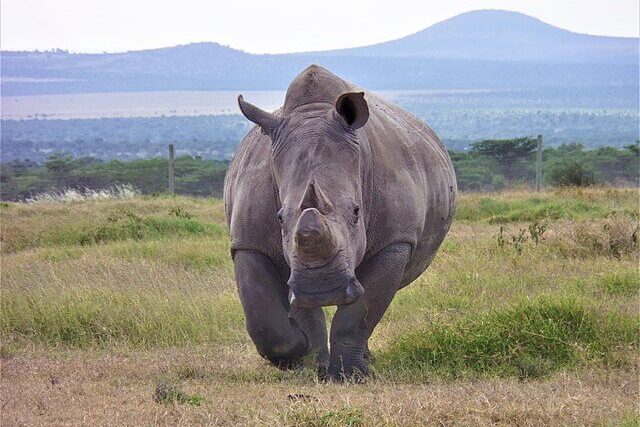
A glimmer of hope has emerged for the northern white rhino, teetering on the edge of extinction with only two individuals left on Earth.
In a monumental breakthrough, scientists have achieved the world’s first successful IVF rhino pregnancy, marking a crucial step in the fight to save this majestic species. Utilising southern white rhinos as surrogate mothers, researchers transferred lab-created rhino embryos with remarkable success.
“To achieve the first successful embryo transfer in a rhino is a huge step,” said Susanne Holtze, a scientist at Leibniz Institute for Zoo and Wildlife Research in Germany, which is part of the Biorescue project, an international consortium trying to save this species.
“But now I think with this achievement, we are very confident that we will be able to create northern white rhinos in the same manner and that we will be able to save the species.”
Once abundant across central Africa, the northern white rhinos fell victim to relentless illegal poaching driven by the insatiable demand for rhino horn. Today, only Najin and Fatu, two females residing at the Ol Pejeta Conservancy in Kenya, represent the last of their kind. Yet, these solitary survivors are unable to propagate, rendering the species functionally extinct.
Enter the Biorescue team, pioneering radical fertility science to orchestrate a resurgence of the northern white rhino. Commencing their groundbreaking work with their southern white counterparts, the team navigated myriad challenges, from egg retrieval from the colossal animals to the delicate process of embryo creation and implantation.
After thirteen painstaking attempts, the team achieved a milestone: a viable IVF pregnancy using southern white rhinos.
“It’s very challenging in such a big animal, in terms of placing an embryo inside the reproductive tract, which is almost 2m inside the animal,” Susanne Holtze said.
Despite the success, tragedy struck as the surrogate mother succumbed to a Clostridia infection, casting a shadow over the breakthrough. Nevertheless, the event underscored the feasibility of IVF as a viable avenue for rhino conservation.
Now, attention turns to the northern white rhinos, with only 30 precious embryos stored in cryogenic preservation in Germany and Italy. These embryos, painstakingly crafted from eggs harvested from Fatu and sperm collected from deceased males, offer a beacon of hope for the species’ revival.
However, logistical hurdles abound. Neither Najin nor Fatu can carry a pregnancy, necessitating the use of a surrogate southern white rhino. Despite being cross-species, the team remains optimistic, buoyed by the success of their previous work.
Prof Thomas Hildebrandt, the director of Liebniz IZW and project head for the Biorescue Consortium, said: “I think the situation for the northern white rhino is quite privileged for the embryo transfer because we have a closely related recipient – so their internal map is nearly the same.”
The impending implantation of the northern white rhino embryos represents a pivotal moment in conservation history. With the Biorescue team poised to commence the procedure in the coming months, hopes are high for the birth of a northern white calf before the last of its kind fades into oblivion.
“We want to preserve the social communication, the social heritage of the northern white rhino by putting the first calf on the ground so they can learn the language from the last two rhinos, they can learn how to behave from them,” explained Prof Hildebrandt.
Yet, the road ahead is fraught with challenges. The lack of genetic diversity poses a significant hurdle to establishing a sustainable population. In parallel, researchers explore experimental techniques, including the creation of rhino gametes from stem cells, to bolster conservation efforts.
Amidst the optimism, some voices caution against excessive investment in a species on the brink of extinction. However, proponents argue that the northern white rhino’s intrinsic value to the ecosystem justifies every effort to ensure its survival.
However, Jan Stejskal, the BioRescue project coordinator from Safari Park Dvur Kralove in the Czech Republic where Najin and Fatu were originally from, said: “One thing that we have to understand is that behind the extinction of the northern white rhino is man. It’s not because of some evolutionary pressure, it was greed, it was the consumption of a rhino horn.
“So, in a way, we are responsible and if we actually have a technique that can assist us to save them, then I think we have a responsibility to use it and to try to save them.”
Samuel Mutisya, head of research and species conservation at Ol Pejeta, underscores the team’s unwavering pursuit to save the northern white rhino, saying that they are “committed to do all that is humanly possible to nurture, protect and recover the species”.
——————————————————————————
At Natural World Fund, we are passionate about stopping the decline in our wildlife.
The decline in our wildlife is shocking and frightening. Without much more support, many of the animals we know and love will continue in their decline towards extinction.
When you help to restore a patch of degraded land through rewilding to forests, meadows, or wetlands, you have a massive impact on the biodiversity at a local level. You give animals a home and food that they otherwise would not have had, and it has a positive snowball effect on the food chain.
We are convinced that this is much better for the UK than growing lots of fast-growing coniferous trees, solely to remove carbon, that don’t actually help our animals to thrive.
This is why we stand for restoring nature in the UK through responsible rewilding. For us, it is the right thing to do. Let’s do what’s right for nature!
Donate today at https://naturalworldfund.com/ and join in the solution!

